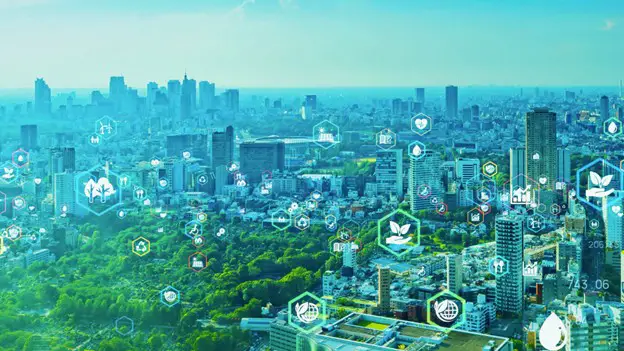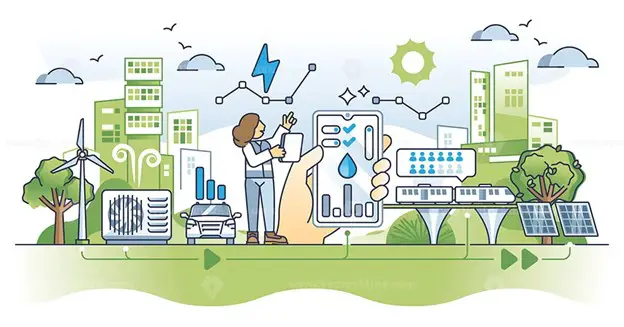Smart Cities of the Future technology, Urban landscape design, Urbanized tech, Sustainable design approach
Smart Cities of the Future: Urban Landscape Technology
26 March 2024
Smart Cities of the Future: How Technology is Shaping the Urban Landscape
The idea of smart cities is a forward-thinking approach to urban planning that makes use of technology to improve the efficiency, sustainability, and quality of life of the people who live there. Cities throughout the world are increasingly turning to cutting-edge technologies to manage the complex difficulties that come with urbanization as the world continues to grow more urbanized.
The purpose of this article is to investigate how technology is influencing the urban landscape and setting the way for the smart cities of the future. Topics covered include intelligent infrastructure and decision-making that is driven by data.
- Intelligent Infrastructure and Connectivity:
Intelligent infrastructure is one of the most important components of smart cities. This infrastructure consists of a network of interconnected sensors, devices, and systems that are designed to improve the efficiency of city operations. Cities can monitor and control key infrastructure in real time thanks to technological advancements such as smart grids and intelligent transportation systems, as well as connected buildings and infrastructure. This results in improvements in efficiency, reliability, and sustainability.
– Shannon Coventry, Car Leasing Expert at First Vehicle Leasing
- Data-Driven Governance and Decision-Making:
The power of data is harnessed by smart cities to improve governance processes and decision-making processes among residents. With the help of the gathering, processing, and display of massive volumes of urban data, city administrators can acquire useful insights into important metrics such as traffic patterns, energy consumption, and air quality. Through the utilization of this data-driven strategy, cities can recognize patterns, anticipate needs, and put into action specific actions to successfully handle urban difficulties.
– Arman Minas, Director at Armstone
- Sustainable Urban Development and Environmental Resilience:
Technology is an essential component in the process of fostering environmentally resilient and environmentally sustainable urban development. Through the implementation of cutting-edge technology, such as renewable energy systems, green building designs, and waste management technologies, smart cities can reduce their negative influence on the environment and increase their resource efficiency. Cities can reduce their carbon footprint while also creating settings that are healthier and more livable for their citizens if they include sustainability principles in their planning and building processes.
– Tiffany Payne, Marketing Manager at iFlooded Restoration
- Enhancing Quality of Life and Citizen Engagement:
Using technology to improve the quality of life and encourage citizen participation, smart cities put the health and happiness of their citizens at the forefront of their urban planning and development efforts. Residents are given the ability to access services, participate in decision-making, and interact with their communities through the use of technology.
This technological advancement includes smart street lighting and public Wi-Fi networks, as well as mobile applications and digital platforms. Through the promotion of a culture that emphasizes transparency, collaboration, and inclusivity, smart cities work toward the creation of urban environments that are vibrant, equitable, and conducive to the flourishing of all citizens.
– Gerrid Smith, Head of Communications at TEXAS PROPERTY TAX LOAN PROS
- Addressing Urban Challenges and Promoting Equity:
Solutions that are driven by technology can address a wide variety of urban difficulties, including but not limited to traffic congestion and air pollution, social inequality, and access to key services. When it comes to urban development, smart cities take a holistic approach, giving justice and inclusivity the highest priority in decision-making and the distribution of resources. By utilizing technology to close the digital gap, enhance access to education, healthcare, and employment opportunities, and create more equitable and resilient communities for all citizens, smart cities aspire to establish communities that are more resilient and egalitarian.
– Cameron Holland, Marketing Director at GB Foam
Conclusion:
It is impossible to overestimate the significance of smart cities in determining the course of urban development in the future for the reason that urban populations are continuing to expand and change. By leveraging the power of technology, smart cities work toward the goal of creating urban settings that are more efficient, sustainable, and livable for the people who live there.
Intelligent infrastructure and data-driven governance are just two examples of how technology is driving transformative change in cities all around the world. Other examples include sustainability programs and public engagement activities. The ongoing development of technology will play a significant part in the realization of the goal of smart cities, which are communities that are inclusive, resilient, and responsive to the needs of all people. This is something that we expect to happen in the future.
Comments on this guide to Smart Cities of the Future: Urban Landscape Technology article are welcome.
Buying Property
Buying Property Posts
How Much Does Home Design Affect the Property Valuation?
Mistakes People Make When Hiring Realtors
4 Tips For Buying Luxury Property In London
Building Design
Architecture
Comments / photos for the Smart Cities of the Future: Urban Landscape Technology page welcome






